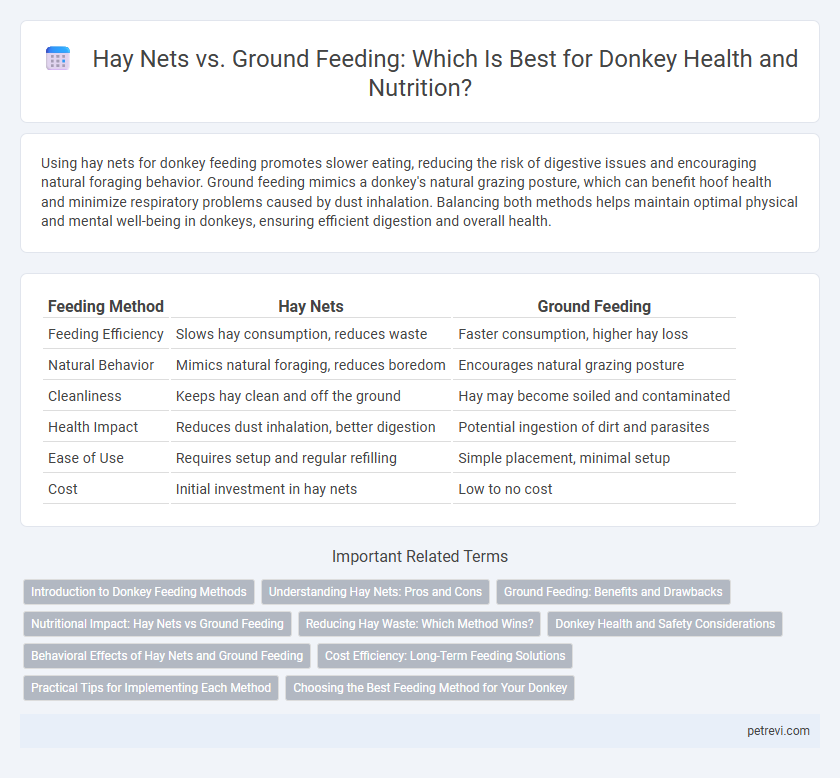Using hay nets for donkey feeding promotes slower eating, reducing the risk of digestive issues and encouraging natural foraging behavior. Ground feeding mimics a donkey's natural grazing posture, which can benefit hoof health and minimize respiratory problems caused by dust inhalation. Balancing both methods helps maintain optimal physical and mental well-being in donkeys, ensuring efficient digestion and overall health.
Table of Comparison
| Feeding Method | Hay Nets | Ground Feeding |
|---|---|---|
| Feeding Efficiency | Slows hay consumption, reduces waste | Faster consumption, higher hay loss |
| Natural Behavior | Mimics natural foraging, reduces boredom | Encourages natural grazing posture |
| Cleanliness | Keeps hay clean and off the ground | Hay may become soiled and contaminated |
| Health Impact | Reduces dust inhalation, better digestion | Potential ingestion of dirt and parasites |
| Ease of Use | Requires setup and regular refilling | Simple placement, minimal setup |
| Cost | Initial investment in hay nets | Low to no cost |
Introduction to Donkey Feeding Methods
Hay nets promote slower, controlled intake of forage for donkeys, reducing waste and mimicking natural grazing behavior. Ground feeding allows donkeys to feed in a natural posture, encouraging normal chewing and digestion, but may increase hay wastage and contamination. Selecting the appropriate feeding method depends on balancing forage preservation with the donkey's feeding habits and health needs.
Understanding Hay Nets: Pros and Cons
Hay nets prevent wastage by containing hay, reducing soil contamination and promoting cleaner feeding for donkeys; however, they may increase the risk of dental wear or injury if not properly sized or monitored. Ground feeding mimics natural foraging behavior, encouraging slower, more natural intake and reducing the likelihood of gastrointestinal issues related to rapid consumption. Selecting the appropriate hay net with correct mesh size and frequent inspection ensures a balance between minimizing waste and maintaining donkey health.
Ground Feeding: Benefits and Drawbacks
Ground feeding for donkeys promotes natural foraging behavior, aiding dental health by encouraging natural wear on teeth and reducing the risk of colic through slow, consistent intake. This method also allows donkeys to exercise and engage in their instinctive grazing patterns, supporting mental stimulation and preventing boredom-related behaviors. However, ground feeding can increase exposure to parasites and contaminants, necessitating regular pasture maintenance and monitoring to ensure optimal health.
Nutritional Impact: Hay Nets vs Ground Feeding
Feeding donkeys using hay nets slows hay consumption, reducing wastage and promoting better digestion by mimicking natural foraging behavior. Ground feeding allows donkeys to eat at their own pace but increases hay contamination with dirt and feces, potentially leading to nutrient loss and digestive issues. Studies show that hay nets can enhance fiber intake quality and minimize gastrointestinal disorders compared to ground feeding methods.
Reducing Hay Waste: Which Method Wins?
Hay nets significantly reduce hay waste for donkeys by limiting the amount they can pull out and trample, unlike ground feeding where hay is scattered and easily soiled. Studies show hay nets can decrease waste by up to 60%, promoting more efficient feeding and cost savings. Ground feeding risks hay contamination with dirt and feces, whereas hay nets keep hay clean and extend its usability.
Donkey Health and Safety Considerations
Hay nets reduce the risk of ingestion of sand and soil, minimizing the chance of colic in donkeys by keeping hay off the ground. Ground feeding, while natural for donkeys, increases the likelihood of parasite ingestion and debris consumption, which can lead to health issues such as gastrointestinal infections. Ensuring clean hay nets and regular inspection of feeding areas supports optimal donkey health and safety.
Behavioral Effects of Hay Nets and Ground Feeding
Hay nets encourage slower, more natural foraging behavior in donkeys by mimicking the prolonged grazing patterns seen in the wild, reducing boredom and preventing obesity. Ground feeding supports the donkey's instinctual snatching and grazing motions, promoting natural digestive health and minimizing dust inhalation. Both methods affect behavioral wellbeing, where hay nets can decrease cribbing and chewing on unwanted objects, while ground feeding enhances social interaction and environmental engagement.
Cost Efficiency: Long-Term Feeding Solutions
Hay nets reduce feed wastage by controlling portions, leading to lower overall hay consumption and cost savings compared to ground feeding. Ground feeding increases the risk of soiled hay, resulting in frequent replacements and higher long-term expenses. Investing in durable, high-quality hay nets offers a cost-efficient feeding solution that minimizes waste and maintains hay quality for donkeys.
Practical Tips for Implementing Each Method
Hay nets offer controlled feeding by slowing donkey consumption and reducing hay wastage, ideal for maintaining dental health and preventing obesity; ensure nets are securely fastened at shoulder height to avoid injuries. Ground feeding mimics natural grazing behavior, promoting mental well-being and reducing dust inhalation, but requires regular cleaning of feeding areas to prevent parasite buildup and contamination. Both methods benefit from frequent monitoring of hay quality and hygiene to optimize donkey nutrition and health.
Choosing the Best Feeding Method for Your Donkey
Hay nets reduce waste by keeping hay off the ground and promoting slower consumption, which aligns with a donkey's natural foraging behavior and helps maintain dental health. Ground feeding allows donkeys to eat in a natural posture, supporting digestion and minimizing the risk of respiratory issues caused by dust or mold particles from elevated feeding. Choosing the best feeding method depends on balancing hygiene, feeding rate control, and the donkey's individual health needs.
Hay nets vs Ground feeding for Donkey Feeding Infographic

 petrevi.com
petrevi.com